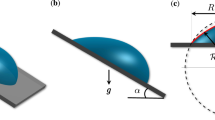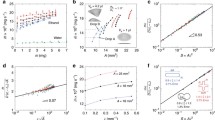Abstract
We analytically solve the Young–Laplace equation for the shape of a stationary sessile droplet pinned to an inclined substrate, assuming that the droplet’s contact line is circular. In the absence of gravity (or an equivalent external field), a sessile droplet takes the form of a spherical cap. Here, we calculate deviations from this ideal geometry when gravitational effects are non-negligible. Our calculations are based on a perturbation solution in powers of the Bond number Bo, which is a dimensionless parameter measuring the strength of gravity relative to surface tension. The newly derived solution is second-order accurate and builds on our previous work (Timm et al. in Sci Rep 9:19803, 2019), where only the leading-order contributions were calculated. We consider the full range of substrate inclination angle from 0 to \(\pi \) and show that, when the second-order corrections are taken into account, the droplet’s profile is captured more precisely and the volume-conservation error of the solution is reduced considerably, all at a modest computational cost. We also find that our solution accurately approximates the gravity-induced deformation of the droplet for a wide range of droplet volumes and Bond numbers. As an example, we can very well predict the distorted shape of a droplet that is hemispherical at zero gravity up to \(\textrm{Bo}\, \approx \,4\), 1.25, and 2.5 when the substrate is tilted from horizontal by 0, \(\pi / 2\), and \(\pi \), respectively. Among other applications, the outcome of our study can serve as the first step toward analyzing the evaporation of sessile droplets deformed by gravity.





Similar content being viewed by others
References
Wilson SK, D’Ambrosio H-M (2023) Evaporation of sessile droplets. Annu Rev Fluid Mech 55(1):481–509
Lv C, Shi S (2018) Wetting states of two-dimensional drops under gravity. Phys Rev E 98(4):042802
Michael D, Williams P (1976) The equilibrium and stability of axisymmetric pendent drops. Proc R Soc Lond A 351(1664):117–127
Chesters AK (1977) An analytical solution for the profile and volume of a small drop or bubble symmetrical about a vertical axis. J Fluid Mech 81(4):609–624
Shanahan MER (1982) An approximate theory describing the profile of a sessile drop. J Chem Soc Faraday Trans 78(9):2701–2710
Dussan EB, Chow RT-P (1983) On the ability of drops or bubbles to stick to non-horizontal surfaces of solids. J Fluid Mech 137:1–29
Rienstra SW (1990) The shape of a sessile drop for small and large surface tension. J Eng Math 24(3):193–202
O’Brien SBG (1991) On the shape of small sessile and pendant drops by singular perturbation techniques. J Fluid Mech 233:519–537
Aussillous P, Quéré D (2006) Properties of liquid marbles. Proc R Soc Lond A 462(2067):973–999
Whyman G, Bormashenko E (2009) Oblate spheroid model for calculation of the shape and contact angles of heavy droplets. J Colloid Interface Sci 331(1):174–177
Extrand C, Moon SI (2010) Contact angles of liquid drops on super hydrophobic surfaces: understanding the role of flattening of drops by gravity. Langmuir 26(22):17090–17099
Lubarda VA, Talke KA (2011) Analysis of the equilibrium droplet shape based on an ellipsoidal droplet model. Langmuir 27(17):10705–10713
Fatollahi AH (2012) On the shape of a lightweight drop on a horizontal plane. Phys Scr 85(4):045401
Park J, Park J, Lim H, Kim H-Y (2013) Shape of a large drop on a rough hydrophobic surface. Phys Fluids 25(2):022102
ElSherbini AI, Jacobi AM (2004) Liquid drops on vertical and inclined surfaces: II. a method for approximating drop shapes. J Colloid Interface Sci 273(2):566–575
Prabhala B, Panchagnula M, Subramanian VR, Vedantam S (2010) Perturbation solution of the shape of a nonaxisymmetric sessile drop. Langmuir 26(13):10717–10724
De Coninck J, Dunlop F, Huillet T (2017) Contact angles of a drop pinned on an incline. Phys Rev E 95(5):052805
Timm ML, Jarrahi Darban A, Dehdashti E, Masoud H (2019) Evaporation of a sessile droplet on a slope. Sci Rep 9:19803
De Coninck J, Fernández-Toledano JC, Dunlop F, Huillet T, Sodji A (2021) Shape of pendent droplets under a tilted surface. Physica D 415:132765
Yariv E (2022) Shape of sessile drops at small contact angles. J Fluid Mech 950:4
Yariv E, Schnitzer O (2023) Shape of sessile drops in the large-bond-number pancakelimit. J Fluid Mech 961:13
Qi W, Li J, Weisensee PB (2019) Evaporation of sessile water droplets on horizontal and vertical biphobic patterned surfaces. Langmuir 35(52):17185–17192
Brakke KA (1992) The surface evolver. Exp Math 1(2):141–165
Brakke KA (1996) The surface evolver and the stability of liquid surfaces. Philos Trans R Soc Lond A 354(1715):2143–2157
Brakke KA (2013) Surface evolver manual. Mathematics Department, Susquehanna University, Selinsgrove
Acknowledgements
Financial support from the Michigan Space Grant Consortium (MSGC) through a graduate fellowship under Award No. 80NSSC20M0124 (M.L.T.) and from KFUPM under Grant No. INRE2327 (R.S.M.A.) is acknowledged.
Author information
Authors and Affiliations
Contributions
All authors performed the analyses, discussed the results, and wrote and reviewed the manuscript.
Corresponding author
Ethics declarations
Conflict of interest
The authors declare no competing interests.
Additional information
Publisher's Note
Springer Nature remains neutral with regard to jurisdictional claims in published maps and institutional affiliations.
Rights and permissions
Springer Nature or its licensor (e.g. a society or other partner) holds exclusive rights to this article under a publishing agreement with the author(s) or other rightsholder(s); author self-archiving of the accepted manuscript version of this article is solely governed by the terms of such publishing agreement and applicable law.
About this article
Cite this article
Timm, M.L., Alassar, R.S.M. & Masoud, H. A second-order-accurate approximation for the shape of a sessile droplet deformed by gravity. J Eng Math 142, 5 (2023). https://doi.org/10.1007/s10665-023-10291-6
Received:
Accepted:
Published:
DOI: https://doi.org/10.1007/s10665-023-10291-6




